Modern Mail Ships Definitives
Issue date: 14th December 2020
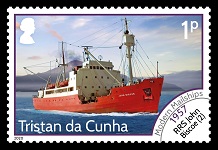 |
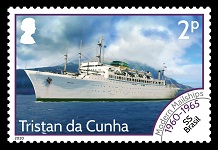 |
||||
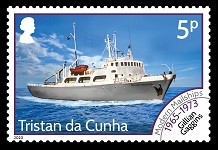 |
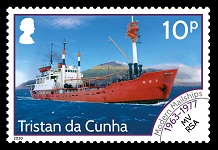 |
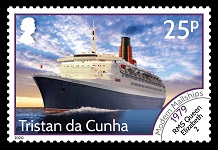 |
|||
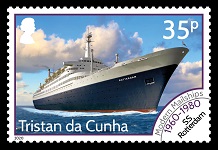 |
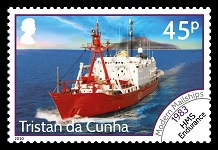
| 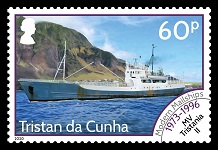 |
|||
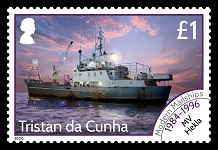 |
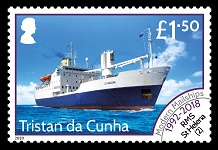 |
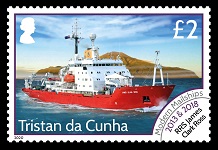 |
|||
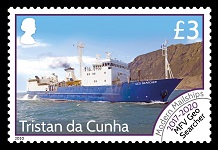 |
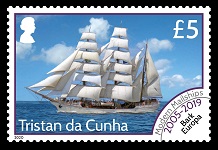 |
||||
| 202013 | Mint Stamps (1p, 2p, 5p, 10p, 25p, 35p, 45p, 60p, £1.00, £1.50, £2.00, £3.00, £5.00) | £14.33 | Shop > |
| 202014 | First Day Cover with 1p, 2p, 5p, £5 stamps | £6.08 | |
| 202015 | First Day Cover with 25p, 45p, £1, £3 stamps | £5.70 | |
| 202016 | First Day Cover with 10p, 35p, 60p, £1.50, £2.00 stamps | £5.55 |
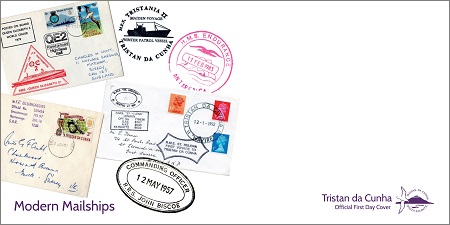
Envelope used for first day covers of this issue.
Tristan da Cunha is the most remote inhabited island in the world lying some 2,430km from St Helena and over 2,800km from Africa. The island was discovered in 1506 by the Portuguese navigator Tristão da Cunha. In 1816 a British garrison was established, and when it was disbanded a year later, Corporal William Glass chose to stay on the island. He can be regarded as the founder of the present community.
Mail from and to the island became very important as it was their only opportunity to communicate with the outside world. Quite often, this could take years, as they were dependent on passing ships, like whalers, to carry the mail. Eventually, after numerous requests, British war ships would call annually but even this waned. Since the fishing concession started around 1950, fishing vessels now call regularly and usually carry mail to and from Tristan, from Cape Town.
This definitive stamp issue, following on from the 2015 Early Mailship Definitives, depicts ships that called at the island between 1957 and 2020. Of course, most of the ships calling at Tristan would carry mail or produce special covers, and as such not all of the ships from this period are included.
1p - RRS John Biscoe (2) (1957)
The second of two ships bearing this name, it was built by Fleming and Ferguson Ltd, Paisley, for the Falkland Island Dependencies Survey (FIDS) and launched in 1956. On her maiden voyage, passengers included HRH Prince Philip, the Duke of Edinburgh, visiting some of the FIDS research stations during the 1956/57 season. Initially the RRS John Biscoe (2) operated as a cargo vessel to resupply FIDS (later BAS) research stations. Increasingly she supported hydrographic and marine biology surveys, and geological landings. Following a major refit in 1979, her role became that of a platform for marine science, particularly the Offshore Biology Programme.
She called at Tristan on 13th May for a few hours, and again on 11th November 1957, with 4 bags of mail, passengers Miss Rhoda Downer, a schoolteacher and Mr Dennis Simpson (Agricultural Officer), Mrs Simpson and their three boys. The John Biscoe lost her motorboat and her barge was washed up on the beach. Some crew was stranded on the island until the storm blew itself out and the islanders were able to use their craft. Miss Downer's luggage had to be repacked so they could get it ashore. RRS John Biscoe brought a lot of cargo for the island including a new X-ray machine presented by the Government for the island hospital.
2p - SS Brasil (1960-1965)
An American cruise liner owned and operated by Moore-McCormack Lines. She first visited on 13th April 1960. Some of the island's two dozen Roman Catholics were able to receive the ministrations of a priest of their Church who was a passenger on-board. On her, second visit on 21st February 1964 heavy seas prevented landings. However, the day before the island mail was taken on-board MV Tristania. This was then transferred to SS Brasil and mail from her was handed over to Captain Scott of MV Tristania for posting ashore when weather improved. Her last visit was on 13th February 1965. The beach was rough and only one boat made it to the ship for bartering.
5p – MFV Gillian Gaggins (1965-1973)
This 1180-ton crayfish-processing vessel was built by Barship in Bayhead (Durban) shipyards in 1965, especially for the South Atlantic Development Cooperation, for rock lobster fishing in Tristan waters. This floating factory and refrigerator vessel replaced the Francis Repetto, which worked alongside the MV Tristania. Her maiden voyage was made in November 1965. After offloading cargo and mail, she took on dinghies for the fishing crew to catch crayfish. By 1970 the dinghies were replaced with a long-line-traps method used by MV Tristania and two small catchers. MFV Gillian Gaggins was altered to a full-time processing, packing and freezing ship to act as a mother ship for the catcher vessels. By 1973, the method of fishing had changed and she was considered outdated and replaced by MV Tristania II who then became the number-one ship.
10p - MV RSA (1963-1977)
The 1573-tonne RSA was South Africa's first Antarctic supply vessel. She was built in Osaka, Japan, and launched in September 1961. Its first visit was on 15th April 1963 bound for Gough Island with meteorology staff. The first ship to call after the Settlement Survey Period bringing mail for 66 islanders and officials. The courageous collection, by dinghy, of mail and gifts in rough weather was illustrated in the National Geographic Magazine (January 1964).
In the next 16 years the RSA (nick-named by some "Rolling Slowly Along") made visits every year to South Africa's meteorological stations on Gough and Marion and in Antarctica to relieve teams or on special voyages for medical or other emergencies. Her last visit to Gough and Tristan was in Oct 1977 and in 1978, the SA Agulhas replaced her.
25p - RMS Queen Elizabeth 2 (1979)
Commissioned in December 1968 the QE2 was built in Clydebank by the Upper Clyde Shipbuilders who had also built the Queen Mary and Queen Elizabeth. The QE2 visit on 8th February 1979 was one that was well remembered by islanders, ship's crew and passengers alike. The ships tenders went ashore and collected all who wanted to come aboard for a visit and afternoon tea. A special party was held for the schoolchildren and afterwards everyone was taken on a tour of the ship. During her visit, two radio officers went ashore to fix the island's short-wave radio transmitter that was broken and would have had to be sent to Cape Town for repair. During her 1985 World Cruise she passed by Tristan for a short non-landing call.
35p - SS Rotterdam (1960-1980)
Built by Rotterdam (Holland) for Holland America Line she became the Holland's largest cruise liner. In 1958, the SS Rotterdam was launched and named by HM Queen Juliana of the Netherlands. She made several calls to Tristan over the years. Capt. A.H.Lagaay wrote, after its morning call off Tristan in 1975, "If and when the Island of Tristan da Cunha is passed in daylight on our annual world cruises the wireless operator on Tristan is always notified that the ship will close in at a set time and asked if any mail can be picked up or services can be rendered". On one call, she only stayed 2 hours and the post office went on board to sell philatelic material.
45p - HMS Endurance (1983)
Built by Kröger-Werft of Germany in 1956 as Anita Dan. The UK government bought her in 1967 and had her converted and commissioned into the Royal Navy as HMS Endurance. As a British Navy Ice Patrol vessel, she supported the UK in Antarctica waters and assisted BAS scientific research programmes.
Bound for Falkland Island on 10th February 1983 she called at Inaccessible Island to take off the Denstone Expedition party. The ship's two small Wasp helicopters collected all the equipment, baggage and official mail transporting it all to HMS Endurance. She then transferred the Denstone group to Tristan. Also on board was the Governor of St Helena, John Massingham, who was greeted by the community, attended official functions and a lively dance in the evening before departing the next day.
60p - Tristania II (1973-1996)
The Faroe fishing vessel Skugvur built in 1964 was renamed Tristania II. This 160-foot steel vessel powered by a Burmiester and Wain 1000hp engine became a new addition to the Tristan Investments Limited fishing fleet, replacing the smaller Tristania. She was converted in Cape Town for fishing using long-lines with traps. She also carried two powerboats that also set traps. She first arrived at Gough on 27th June and then Tristan on 5th July 1973. The Tristania II fished at Tristan islands up until 1996. She carried passengers, mail and a small amount of cargo to and from Tristan until the Kelso replaced her in 1997.
£1 - MV Hekla (1984-1996)
The Hekla, a 68m steel ship converted from a cargo vessel, for longline fishing, processing and packing for export replaced the Hilary in 1984. On her first trip to Tristan she encountered mechanical problems and took 10 days to complete the journey. Her last voyage as Hekla was on 12th December 1996. This vessel not only served as a factory-fishing vessel but also provided Tristan's main link to the outside world carrying cargo, mail and a maximum of 12 passengers each trip.
A new concession was granted in 1997 and she was re-named MV Edinburgh. The MV Edinburgh continues to call at Tristan each year and remains a vital lifeline for islanders.
£1.50 - RMS St Helena (2) (1992-2018)
Built by Hall, Russell & Company in Aberdeen the RMS (as it was locally known) entered service in 1990. A cargo liner (carrying cargo and passengers) she served the island of Saint Helena sailing between Cape Town and Saint Helena with regular shuttles continuing to Ascension Island. She visited Portland, Dorset twice a year until 14 October 2011, when she set sail on her final voyage from the English port. Her first visit to Tristan was in 1992 as she was due to call in 1991 but had to cancel due to engine trouble. Over the years, she called at Tristan on several occasions and was always welcomed by the islanders. Her last call was on 4th January 2018 from there, she sailed to St Helena departing on 10th February 2018 for her last trip to Cape Town.
At the time of her retirement from St Helena service, she was one of only four ships in the world still carrying the status of Royal Mail Ship.
£2 - RRS James Clark Ross (2013-2018)
In 1991, the RRS James Clark Ross, named after Admiral Sir James Clark Ross, R.N, became the first BAS vessel to be purpose-built as a science platform. She is primarily a marine research vessel for biological, oceanographic and geophysical cruises.
In 2013, the James Clark Ross spent two days at Gough and six days at Tristan, recording and sampling seabed life and completing midwater trawls. On 31st March 2018 she called again as part of the Blue Belt 3-year research programme focusing on the seamounts within the Tristan EEZ.
£3 – MFV Geo Searcher (2017-2020)
Built in 1982 at 1863 gross tonnes, 69m in length and refurbished in 2005 and 2014, it originally served as a scientific research vessel. The Geo Searcher was purchased by Ovenstone Agencies in 2016 to replace the MV Edinburgh as the island's main fishing vessel. It was converted in Gdansk, Poland, to a factory freezer vessel with cargo and passenger capacity. In April 2017, she made her maiden voyage to Tristan and Gough Island. The Geo Searcher fished around the three outer islands of Inaccessible, Nightingale and Gough Island and catches were processed and frozen on-board. On each voyage, she carried mail, passengers and cargo.
On the morning of 15 October 2020, while fishing off the north-western coast of Gough Island the Geo Searcher foundered on a rock and sank. All 62 seamen on board, including two Tristanian Fisheries Observers, safely abandoned ship and made their way to the South African Meteorological Station at the south-eastern end of the island, where they were winched ashore. The SA Agulhas II was dispatched from Cape Town to rescue the seamen from Gough. She called at Tristan on 22nd to drop off the two islanders before continuing to Cape Town, arriving on Monday 26th October.
£5 - Bark Europa (2005-2019)
The Bark Europa, operated by Hapag-Lloyd line, first called at Tristan on 3rd April 2005. She was en route from a cruise to South Georgia and due to the fine weather and sea conditions, passengers and crew were able to come ashore, explore the island and purchase stamps, handicrafts and souvenirs. The Bark Europa has continued to call at Tristan and its outer islands most years since then, and the islanders welcome its regular visits.
Technical Specifications from Pobjoy Mint Ltd.
| Designer: | Andrew Robinson | ||
| Printer: | bpost | Stamp size: | 42.02 x 27.66mm |
| Process: | Lithography | Perforation: | 11½ per 2cms |
| Production Co-ordination: | Creative Direction (Worldwide) Ltd | Sheet format: | 10 |
